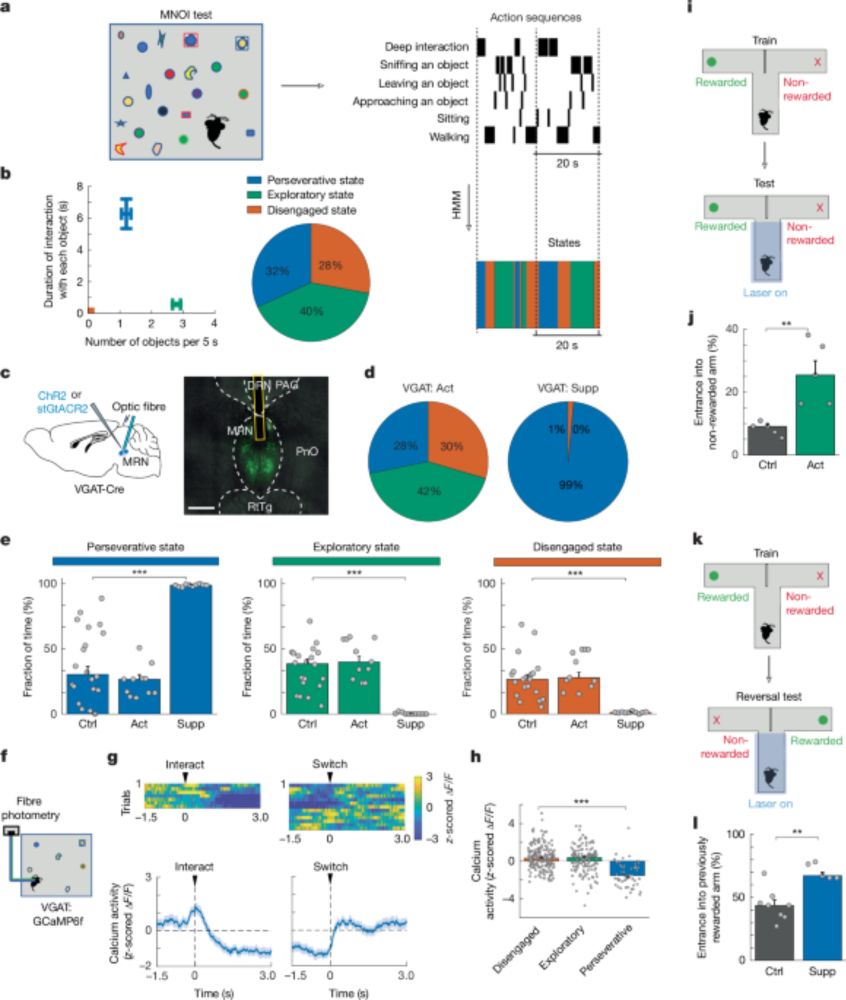
Kris Jensen
@kristorpjensen.bsky.social
Computational neuroscientist || Postdoc with Tim Behrens || Sainsbury Wellcome Centre @ UCL
Pinned
Kris Jensen
@kristorpjensen.bsky.social
· Sep 24
I’m super excited to finally put my recent work with @behrenstimb.bsky.social on bioRxiv, where we develop a new mechanistic theory of how PFC structures adaptive behaviour using attractor dynamics in space and time!
www.biorxiv.org/content/10.1...
www.biorxiv.org/content/10.1...
I’m super excited to finally put my recent work with @behrenstimb.bsky.social on bioRxiv, where we develop a new mechanistic theory of how PFC structures adaptive behaviour using attractor dynamics in space and time!
www.biorxiv.org/content/10.1...
www.biorxiv.org/content/10.1...
September 24, 2025 at 12:04 PM
I’m super excited to finally put my recent work with @behrenstimb.bsky.social on bioRxiv, where we develop a new mechanistic theory of how PFC structures adaptive behaviour using attractor dynamics in space and time!
www.biorxiv.org/content/10.1...
www.biorxiv.org/content/10.1...
Great paper by @jonathannicholas.bsky.social and @marcelomattar.bsky.social !
A related discussion we had in our lab recently is whether there exists convincing evidence that mice use episodic memory - refs are welcome if anyone knows relevant work!
A related discussion we had in our lab recently is whether there exists convincing evidence that mice use episodic memory - refs are welcome if anyone knows relevant work!
Why do we remember so many details of our experiences even when it is unclear if we will actually ever need them?
In a new preprint, @marcelomattar.bsky.social and I asked whether this property is adaptive, because what will be relevant in the future often (usually?!) isn’t apparent.
In a new preprint, @marcelomattar.bsky.social and I asked whether this property is adaptive, because what will be relevant in the future often (usually?!) isn’t apparent.

Episodic memory facilitates flexible decision making via access to detailed events
Our experiences contain countless details that may be important in the future, yet we rarely know which will matter and which won't. This uncertainty poses a difficult challenge for adaptive decision ...
www.biorxiv.org
March 14, 2025 at 6:25 PM
Great paper by @jonathannicholas.bsky.social and @marcelomattar.bsky.social !
A related discussion we had in our lab recently is whether there exists convincing evidence that mice use episodic memory - refs are welcome if anyone knows relevant work!
A related discussion we had in our lab recently is whether there exists convincing evidence that mice use episodic memory - refs are welcome if anyone knows relevant work!
Amazing work by Mehran, @sonjahofer.bsky.social, and colleagues, characterizing neural mechanisms underlying explore/exploit behaviours!
Should you stick to your goal, try something else, or give up? Your median raphe nucleus in the brainstem knows and will decide for you 😉. First foray of my lab into foraging, behavioural strategies and exploration. Amazing work from the one and only Mehran Ahmadlou: www.nature.com/articles/s41...

A subcortical switchboard for perseverative, exploratory and disengaged states - Nature
Behavioural experiments in mice demonstrate that GABAergic (γ-aminobutyric acid-expressing), glutamatergic and serotonergic neurons in the median raphe nucleus have distinct and complementary function...
www.nature.com
March 6, 2025 at 9:47 PM
Amazing work by Mehran, @sonjahofer.bsky.social, and colleagues, characterizing neural mechanisms underlying explore/exploit behaviours!
Reposted by Kris Jensen
New paper from the lab!
Mathias Sablé-Meyer used behavior, fMRI and MEG to study the mental representation of geometric shapes (quadrilaterals ranging in regularity from squares and rectangles to random figures).
www.biorxiv.org/content/10.1...
Mathias Sablé-Meyer used behavior, fMRI and MEG to study the mental representation of geometric shapes (quadrilaterals ranging in regularity from squares and rectangles to random figures).
www.biorxiv.org/content/10.1...
www.biorxiv.org
February 7, 2025 at 1:44 PM
New paper from the lab!
Mathias Sablé-Meyer used behavior, fMRI and MEG to study the mental representation of geometric shapes (quadrilaterals ranging in regularity from squares and rectangles to random figures).
www.biorxiv.org/content/10.1...
Mathias Sablé-Meyer used behavior, fMRI and MEG to study the mental representation of geometric shapes (quadrilaterals ranging in regularity from squares and rectangles to random figures).
www.biorxiv.org/content/10.1...
Reposted by Kris Jensen
For my first Bluesky post, I'm very excited to share a thread on our recent work with Mitra Javadzadeh, investigating how connections between cortical areas shape computations in the neocortex! [1/7] www.biorxiv.org/content/10.1...

Dynamic consensus-building between neocortical areas via long-range connections
The neocortex is organized into functionally specialized areas. While the functions and underlying neural circuitry of individual neocortical areas are well studied, it is unclear how these regions op...
www.biorxiv.org
January 31, 2025 at 2:57 AM
For my first Bluesky post, I'm very excited to share a thread on our recent work with Mitra Javadzadeh, investigating how connections between cortical areas shape computations in the neocortex! [1/7] www.biorxiv.org/content/10.1...
Reposted by Kris Jensen
663 days since the senseless tragedy that took An, we present a manuscript that reports some of the discoveries that she left us.
www.biorxiv.org/content/10.1...
www.biorxiv.org/content/10.1...

Targeted stimulation of motor cortex neural ensembles drives learned movements
During the execution of learned motor skills, the neural population in the layer 2/3 (L2/3) of the primary motor cortex (M1) expresses a reproducible spatiotemporal activity pattern. It is debated whe...
www.biorxiv.org
January 7, 2025 at 5:53 AM
663 days since the senseless tragedy that took An, we present a manuscript that reports some of the discoveries that she left us.
www.biorxiv.org/content/10.1...
www.biorxiv.org/content/10.1...
I wrote an introduction to RL for neuroscience last year that was just published in NBDT: tinyurl.com/5f58zdy3
This review aims to provide some intuition for and derivations of RL methods commonly used in systems neuroscience, ranging from TD learning through the SR to deep and distributional RL!
This review aims to provide some intuition for and derivations of RL methods commonly used in systems neuroscience, ranging from TD learning through the SR to deep and distributional RL!
An introduction to reinforcement learning for neuroscience | Published in Neurons, Behavior, Data analysis, and Theory
By Kristopher T. Jensen. Reinforcement learning for neuroscientists
tinyurl.com
December 21, 2024 at 5:59 PM
I wrote an introduction to RL for neuroscience last year that was just published in NBDT: tinyurl.com/5f58zdy3
This review aims to provide some intuition for and derivations of RL methods commonly used in systems neuroscience, ranging from TD learning through the SR to deep and distributional RL!
This review aims to provide some intuition for and derivations of RL methods commonly used in systems neuroscience, ranging from TD learning through the SR to deep and distributional RL!

